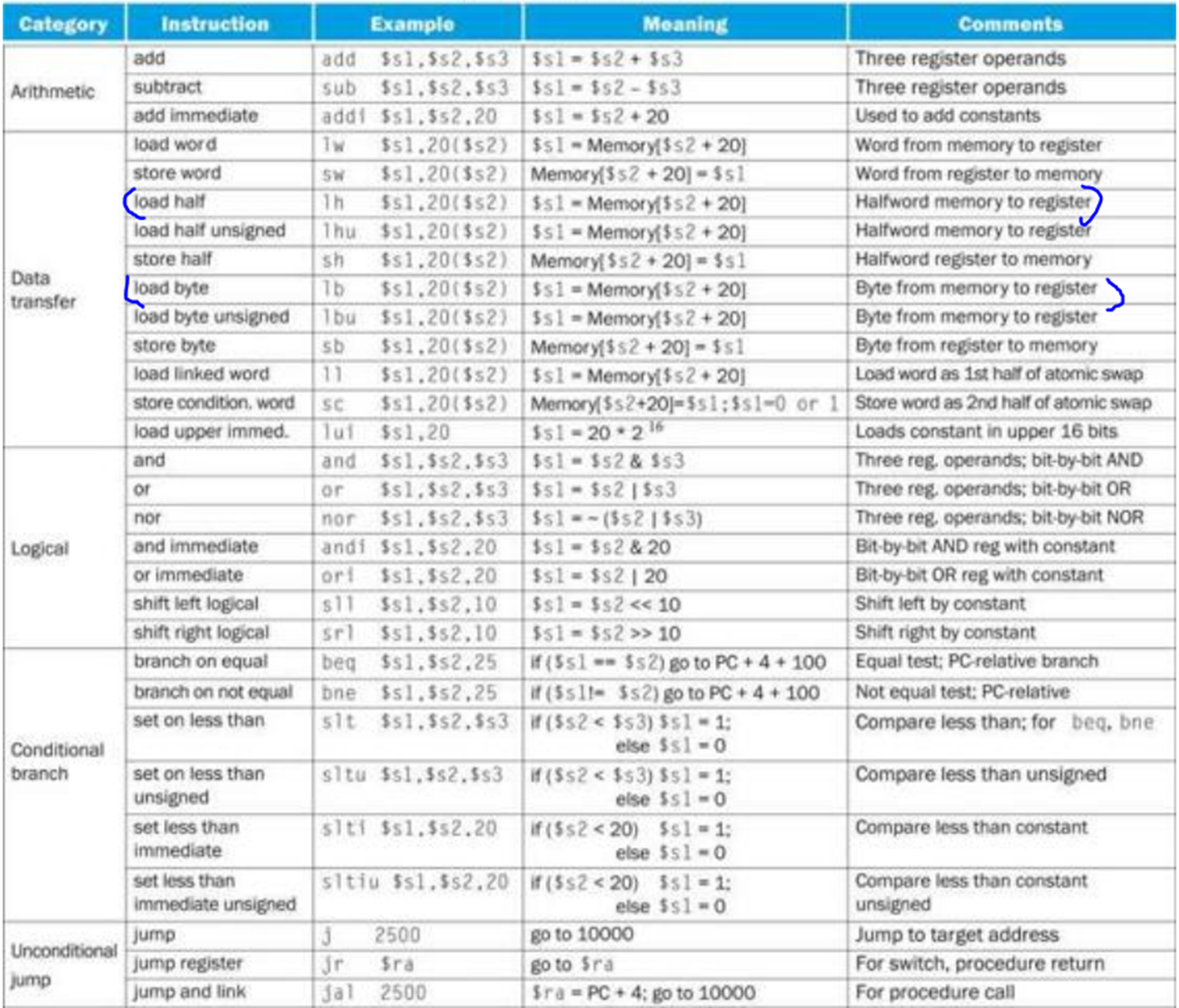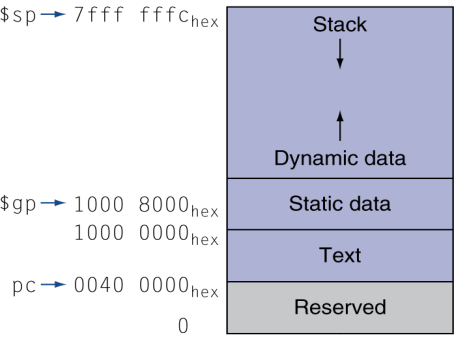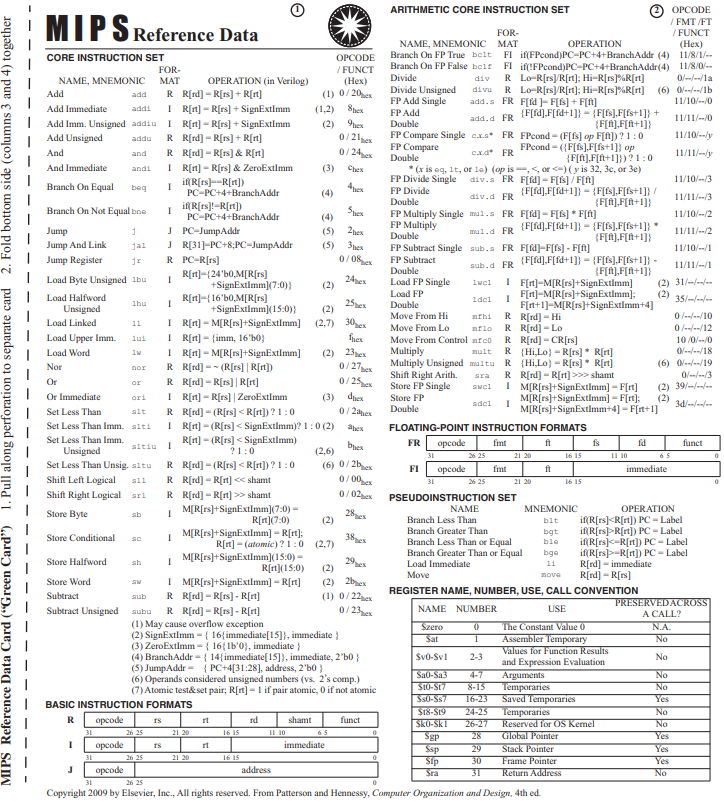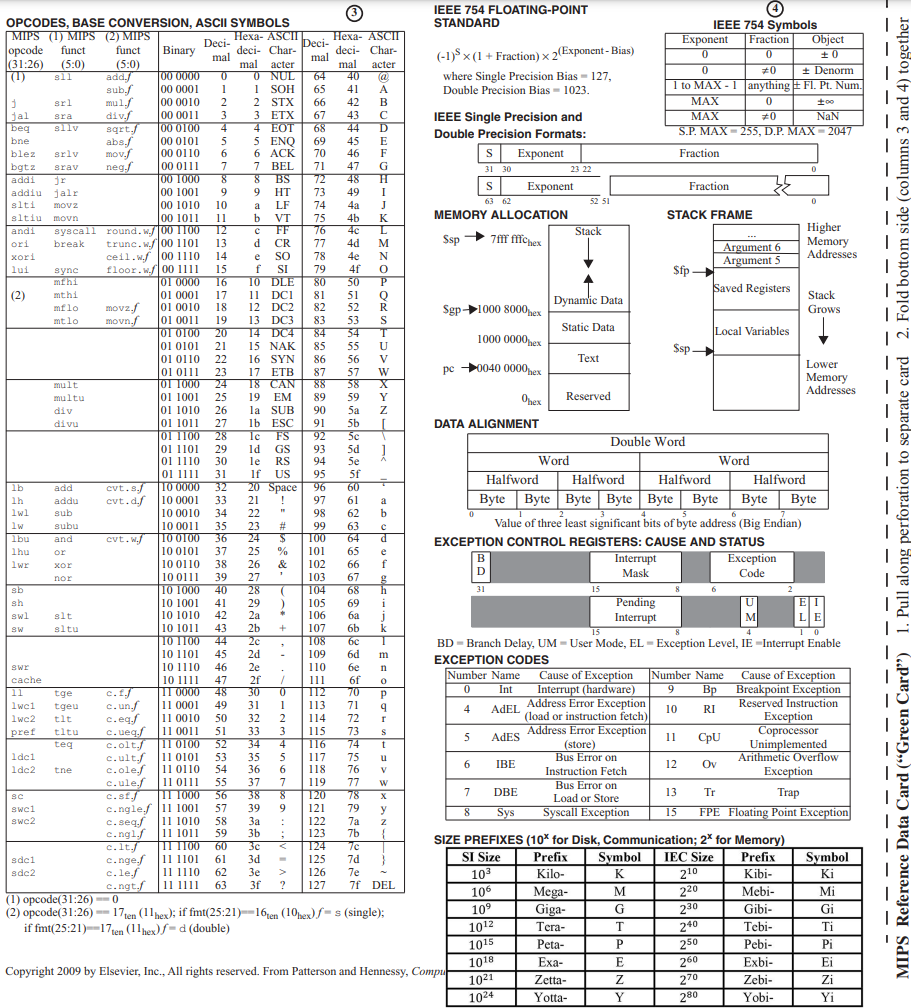[CA2] Instructions; Language of the computer
2.1. Introduction
컴퓨터 하드웨어에 명령을 내리기 위해, 우리는 하드웨어의 언어를 할 줄 알아야 한다.
instruction: Words of a computer’s language.
[1]instruction set: Vocabulary of computer.
instruction set Example:
- RISC: Reduced Instruction Set Computer (contrasting concept: CISC)
- e.g. MIPS, ARM, Power PC, etc.
Computer “Architecture” defines…
- Instruction Set Architecture
- Instruction Set
- Operand types
- Data Types (integers, FPs, …)
- Memory addressing modes, …
- Registers and other state
- The interrupt/exception model
- Memory management and protection
- Virtual and physical address layout
- IO model
- Chapter Goal
- Know how to represent instructions.
Overview
- Learn how to represent instructions.
- Discover the [2]stored-program concept
- Exercise the “forieign language” skills by writing Assembly programs & running them on the simulator that comes with this book.
- See the impact of programming languages and compiler optimization on prformance.
- Historical evolution of instruction sets.
2.2. Operations of the Computer Hardware
The MIPS instruction set
- Used as the example throughout the book.
- Stanford MIPS commercializd by MIPS technologies
- Typical of many modern ISAs.
- Similar ISAs have a large share of embedded core market.
- Applications in consumer eletronics, network/storage equipment, cameras, printers, …
- Almost 100 million MIPS processors manufactured in 2002. \cf
[ Register name, Number, Use, Call Convention ]
[2.8]
| Name | Number | Use | Preserved Across a Call? |
|---|---|---|---|
| $zero | 0 | The constant value 0 | n.a. |
| $at | 1 | Assembler Temporary | No |
| $v0-$v1 | 2-3 | Values for function Results and Expression Evaluation | No |
| $a0-$a3 | 4-7 | Arguments | No |
| $t0-$t7 | 8-15 | Temporaries | No |
| $s0-$s7 | 16-23 | Saved Temporaries | Yes |
| $t8-$t9 | 24-25 | Temporaries | No |
| $k0-$k1 | 26-27 | Reserved for OS Kernel | No |
| $gp | 28 | Global Pointer | Yes |
| $sp | 29 | Stack Pointer | Yes |
| $fp | 30 | Frame Pointer | Yes |
| $ra | 31 | Return Address | Yes |
- 0 is zero.
- 1 is at (assembly temp).
- v(2~): 2
- a(4~): 4
- t(8~): 10
- s(16~): 8
- k: 2. Betweens.
- 28~31: Specials
암기: zavatskgsfra (?)

[ MIPS instructions ]
| Category | Instruction | Example | Meaning | Comments |
|---|---|---|---|---|
| Arithmetic | add | add $s1,$s2,$s3 | $s1 = $s2 + $s3 | Three register operands |
| Arithmetic | subtract | sub $s1,$s2,$s3 | $s1 = $s2 - $s3 | Three register operands |
| Arithmetic | add immediate | addi $s1,$s2,20 | $s1 = $s2 + 20 | Used to add constants |
| Data transfer | load word | lw $s1,20($s2) | $s1 = Memory[$s2+20] | Word from memory to register |
| Data transfer | store word | sw $s1,20($s2) | Memory[$s2+20] = $s1 | Word from register to memory |
| Data transfer | load byte | lb $s1,20($s2) | $s1 = (signed)Memory[$s2+20] | Byte from mem to reg with sign extension. |
| Data transfer | load byte unsigned | lbu $s1,20($s2) | $s1 = (unsigned)Memory[$s2+20] | Byte from mem to reg, unsigned. |
| Data transfer | load half | lh $s1,20($s2) | $s1 = Memory[$s2+20] | Halfword memory to register |
| Data transfer | load half unsigned | lhu $s1,20($s2) | $s1 = Memory[$s2+20] | Halfword memory to register |
| Data transfer | store half | sh $s1,20($s2) | Memory[$s2+20] = $s1 | Halfword register to memory |
Fixation of operand #s in arithmetic operators (as 3) demonstrates regularity.
This illustrates first of the three underlying principles of hardware design:
HW Design Principle 1
| Design Principle 1: Simplicity favors regularity. |
(form of arithmetic operations)
- Regularity makes implementation simpler
- Simplicity => high perf / low cost
Example: Changing the below C code into Assembly.
f = (g + h) - (i + j);
Compiled MIPS code (Assembly)
- $s0: f
- $s1: g
- $s2: h
- $s3: i
- $s4: j
add $t0, $s1, $s2 # temp t0 = g + h
add $t1, $s3, $s4 # temp t1 = i + j
sub $s0, $t0, $t1 # f = t0 - t1
2.3. Operands of the Computer Hardware
- registers: limited number of special locations built directly in hardware.
- [3]word: Unit of access in a computer; corresponds to the size of a register in the MIPS architecture.
- MIPS has a 32 * 32-bit register file. => word: 32 bits
HW Design Principle 2
| Smaller is faster. |
The reason for the limit of 32 registers:
Large number of register => Increase clock cycle time
∵ it takes longer electronic signals.
Memory Operands
- [4]data transfer instruction:
- load: Copies data from memory to a register.
- store: Complementary D.T.I. to load: copies data from a register to a memory.
- [5]address: A value denoting the location of a specific data element within a memory array.
- MIPS uses byte addressing: 1 Address difference leads to 1 byte location difference in memory.
-
[6]Alignment restriction: Word must start at addresses that are multiples of 4.
- Base address: Starting address (of an array)
- Base register: The register added to an offset to form an address (i.e. representing base address.)
- Offset: The constant in a data transfer instruction.
Example:
g = h + A[8];
- g: $s1
- h: $s2
- A: Array of 100 words.
- Base register storing base address of A: $s3.
lw $t0, 32($s3) # Temp reg $t0 gets A[8]
add $s1, $s2, $t0 #
Example:
A[12] = h + A[8];
- h: $s2
- Base Address of A at : $s3.
lw $t0, 32($s3) # Temp reg $t0 gets A[8]
add $t0, $s3, $t0
sw $t0, 48($s3)
Q. Why using base register is beneficial?
A. We can address wider range of memory.
- Using only 5 bits of instruction to stress the base register, we can address 2^32 byts of memory,
- whereas merely \(2^5\) bytes would be addressible did we use it not as base register, but as the address itself.
cf. Concepts
- Endianness:
- Big endian: Put most-significant byte at least address of a word.
- Little endian: Put least-significant byte at least address of a word.
- spilling registers: Process of putting less commonly used variables into memory.
- Registers (than memory):
- Less access time
- Higher throughput
- Less energy
=> Compilers must use registers efficiently. \cf
Constants or Immediate Operators
common case fast: Using frequency to justify the inclusions of constants.
- Small constants are common.
-
Immediate operand avoids a load instruction.
- addi: Avoid the load instructions from constant numbers to add a constant.
- $zero: Value zero.
addi $s3, $s3, 4 # $s3 = $s3 + 4
cf. MIPS supports negative consts => No need for subi.
2.4. Signed & Unsigned Numbers
Meh, You know.
Terms:
- binary digits: One of the two numbers in base 2, 0 or 1, that are the components of information.
- least significant bit: The rightmost bit in a MIPS word.
- most significant bit: The leftmost bit in a MIPS word.
- overflow: When the results of an operation are larger than can be represented in a register.
MIPS instructions
- lb (I format)
-
lbu (I format) e.g. Representing characters.
- 2’s complement: Unsigned sum of an n-bit int and its n-bit negative is 2^n. Sign bit == MSB in this case.
- sign extension: The leftmost bit in a MIPS word.
- Converting m bit integer to n(>m) bit integer.
- Signed: Replicate the most significant bit to the left.
- Unsigned: Extend with 0s.
- negation:
- x: signed int.
- \(\bar{x}\): every bit inverted of x.
- \[x + \bar{x} = -1\]
- \[∴ -x = \bar{x} + 1\]
- sign extension: The leftmost bit in a MIPS word.
2.5. Representing Instructions in the Computer
Terms
- field: Certain segments of instructions.
- instruction format: A form of representation of an instruction composed of fields of binary numbers.
- machine language: Binary representation used for communication within a computer system.
- hexadecimal: Numbers in base 16.
- opcode: The field that denotes the operation & format of an instruction.
Instruction Formats
regularity: All instructions encoded as 32-bit instruction words.
Different formats complicate decoding, but commonly allow 32-bit instructions.
HW Design Principle 3
| Design Principle 3: Good design demand good compromises |
- R-type(=R-format) (R: Register)
- Instruction Fields

- op: operation code (opcode)
- rs: first source register number
- rt: second src register num
- rd: destination register num
- shamt: shift amount (00000 for now)
- funct: function code (extends opcode)
- Examples:
- Arithmetic ops.
- Instruction Fields
- I-type(/format) (for immediate)
- Instruction Fields

- Examples:
- Immediate arithmetic ops
- load/store instructions
- Usage:
- rs: base register or second operand of assembly.
- rt: the register (that stores the result) or first operand of assembly.
- immediate: const(\(-2^15\) to \(2^15 - 1\)) or address(offset added to base address in rs.)
- Instruction Fields
- J-type(/format) (J: Jump)
- Instruction Fields

- Examples:
- Jump Instructions (j and jal)
- Address: encode 26-bit target address
- jal: save the address of the nxt(=following) instruction in $ra and jump to an address.
- Jump Instructions (j and jal)
- Instruction Fields
Example:
Convert this into the corresponding MIPS machine instruction.
add $t0, $s1, $s2
Solution:
- add is R-format. OPCODE/FUNCT: 0/20(hex)
- Therefore the fields are as follows:
- opcode: 0
- rs: $s1
- rt: $s2
- rd: $t0
- shamt: 0
- funct: 20 (hex) Thus the machine code would be as follows:
000000 10001 10010 01000 00000 100000
(0000 0010 0011 0010 0100 0000 0010 0000) as hex, 0232 4020
Example:
- C code
A[300] = h + A[300]; - Assembly code (A: 4-byte array, base addr in $t1, h: $s2)
lw $t0, 1200($t1) add $t0, $s2, $t0 sw $t0, 1200($t1) - Machine code
- Instructions and formats
- add: R
- lw, sw: I
- Fields:
- add:
- opcode/funct: 0/32
- rs: $s2 => 18
- rt: $t0 => 8
- rd: 8
- shamt: 0
- lw, sw:
- opcode: 35, 42
- rs: $t1 (base reg!) => 9
- rt: $t0 (just reg!) => 8
- immediate: 1200.
operation op rs rt rd shamt funct add 0 18 8 8 0 32 lw 35 9 8 1200 sw 43 9 8 1200 - add:
lw->add->sw.
100011 01001 01000 0000 0100 1011 0000 000000 10010 01000 01000 00000 100000 101011 01001 01000 0000 0100 1011 0000 - Instructions and formats
Example:
addi $s1, $s2, 100
| opcode | rs | rt | immediate |
| 8 | 18(for $s2) | 17(for $s1) | 100 |
2.6. Logical Operators
Terms:
- AND: A logical bit-by-bit operation with two operands that calculates a 1 only if thre is a 1 in both operands.
- Application: Mask bit in a word (select some bits, clear others to 0)
- OR: A logical bit-by-bit operation with two operands that calculates a 1 if there is a 1 in either operand.
- include bits in a word.
- NOT: A logical bit-by-bit operation with one operand that inverts the bits; that is, it replaces every 1 with a 0 and every 0 with a 1.
- NOR (NOT OR): A logical bit-by-bit operation with two operands that calculates the NOT of the OR of the two operands. That is, it calculates a 1 only if there is a 0 in both operands.
- cf. XOR: A binary bit operation that returns 1 iff the two bits differ.
Ops:
- sll: shift left logical (R)
- rs=0 (unused)
- e.g. sll $t2, $s0, 4 => $t2 = $s0 « 4. (sllop 0 16 10 4 (shamt) sllfunc)
- srl: shift right logical
- and, andi: and. nyum.
- and (R) (e.g. and $t0 $s1 $s2 nyum nyum) (nyum. andop 17 18 8 0 andfunc)
- andi (I) (e.g. andi $s1 $t0 24 => nyum nyum) (nyum. andiop 8 17 24. )
- or, ori
- nor(R): A NOR B == NOT (A OR B)
-
- noring an argument with 0 leads to not.
-
2.7. Instructions for Making Decisions
Terms:
- conditional branches: An instruction that requires the comparison of two values and that allows for a subsequent transfer of control to a new address in the program based on the outcome of the comparison.
- basic block: A sequence of instructions without…
- branches (except possibly at the end) and
- branch targets or branch labels (except possibly at the beginning).
- jump == unconditional branches
- jump (address) table: A table of addresses of alternative instruction sequences.
Ops:
- beq rs, rt, L1 (I)
- if rs == rt, then Branch to instruction labeled L1.
- bne rs, rt, L1
- if rs != rt, then Branch to instruction labeled L1.
- j L1
- Unconditional jump to instruction labeled L1.
- Comparison instructions (4)
- slt (set less than) rd, rs, rt
- if(rs < rt) rd = 1; else rd = 0;
- slti rt, rs, const
- sltu (nyum.)
- Special usage: index-out-of-bounds checking.
- e.g.
# see if $t0 < $s1 and $t0 >= 0, where $s1 > 0. Else, out-of-bound. sltu $t1, $t0, $s1 beq $t1, $zero, IndexOutOfBounds
- sltiu (nyum)
- slt (set less than) rd, rs, rt
2.8. Supporting Procedures in Computer Hardware
Terms:
- procedure (‘function’): A stored subroutine that performs a specific task based on the parameters with which it is provided.
- jump-and-link instruction: An instruction that jumps to an address and simultaneously saves the address of the following instruction in a register($ra in MIPS).
-
return address: A link to the calling site that allows a procedure to return to the proper address; in MIPS it is stored in register $ra.
- caller: The program that instigates a procedure and provides the necessary parameter values.
- callee: A procedure that executes a series of stored instructions based on parameters provided by the caller and then returns control to the caller.
- program counter (PC): The register containing the address of the instruction in the program being executed.
- stack: A data structure for spilling registers organized as a last-in-first-out queue.
- push: Add element to stack.
- pop: Remove element from stack.
-
stack pointer: A value denoting the most recently allocated address in a stack that shows where registers should be spilled or where old register values can be found. In MIPS, it is register $sp.
- global pointer: The register that is reserved to point to the static area.
- procedure frame(= activation record): The segment of a stack containing a procedure’s saved registers and local variables.
- frame pointer: A value denoting the location of the saved registers and local variables for a given procedure.
- text segment: Th segment of a UNIX object file that contains the machine language code for routines in the source file.
Concepts
Procedure Calling Step
- Caller places params in argument registers for the procedure(callee).
- $a0-$a3: Argument registers to pass params.
- Caller transfer control to the callee. (This also assigns $ra the next instruction.)
- jal Func
- Callee acquires storage resources for the procedure
- addi $sp, $sp, -4*n
- Callee performs the desired task.
- Callee puts the return value in value registers for the caller.
- $v0-$v1: Value registers to return result values.
- Callee returns control to the caller.
- Done by: jr $ra.
Instructions
- jr: jump to a register specified. e.g. $ra.
- jal: jump-and-link. Jumps to an address and simultaneously saves the address of the following instruction in a register ($ra in MIPS)
Nested Procedures (non-leaf procedures)
: procedures that call others.
For nested calls, the caller needs to save on the stack:
- Its return address
- Any arguments and temporaries needed after the call.
Restore from the stack after the call.
Note: Which register values must be preserved during a procedure call? [reg table]
- $s0-$s7
- $sp, $ra(, $fp, $gp) ( () : if used.) (- stack above the stack pointer.)
Allocating Space for new Data on the Stack
How to save all the values of the registers that must be saved & can be modified?
We simply use the memory section: stack.
- Allocation of space: just add -4(=word size)*(reg size) to the $sp.
- Location of space: address via ($sp + 4*n), etc. (or sometimes $fp-4*n can be used.)
- Deallocate after loading the needed information back in the registers and restore $sp value.
Registers
- $ra (return address): A link to the calling site that allows a procedure to return to the proper address.
- $sp : A value denoting the most recently allocated address in a stack that shows whre registers should be spilled or where old register values can be found.
- Stack GROWS from HIGHER to LOWER addresses.
- $fp: Points to the first word of the (stack) frame of a procedure. Used as a stable base register within a procedure for local memory references.
Example: Factorial Code
C code:
int fact(int n) {
if(n<1) return 1;
else return n * fact(n-1);
}
- argument n in $a0
- result in $v0
MIPS code:
Fact:
slti $t0, $a0, 1
bne $t0, $zero, Base
addi $sp, $sp, -1
sw $ra, 0($sp) # This must be done!
addi $a0, $a0, -1
jal Fact # Because of this! Non-leaf!
lw $ra, 0($sp)
addi $sp, $sp, 4
addi $a0, $a0, 1
mul $v0, $v0, $a0
jr $ra
Base:
addi $v0, $zero, 1
jr $ra
Memory Layout
- Text: program code
- static data: global variables
- e.g. static variables in C, constant arrays and strings
- $gp initialized to address allowing ±offsets into this segment.
- dynamic data: heap

2.9. Communicating with People
ASCII encoding: A representation of characters offered by most computers today.
characters are represented into integers 0-127 (7 bits). This consumes 1 byte.
https://en.wikipedia.org/wiki/ASCII
MIPS Instructions: (for Byte/Halfword Operations: )
Sign extending loads
- lb rt, offset(rs)
- lh rt, offset(rs)
Zero extending loads
- lbu rt, offset(rs)
- lhu ret, offset(rs)
No extending store
- sb rt, offset(rs)
- sh rt, offset(rs)
Example: String Copy (null-terminated strings)
C code:
void strcpy (char x[], char y[]) {
int i;
i = 0;
while ((x[i]=y[i]) != '\0')
i+=1;
}
- Addresses of x, y in $a0, $a1
- i in $s0
strcpy:
1 addi $sp, $sp, -1
2 sw $s0, 0($sp)
3 add $s0, $zero, $zero
Loop:
4 sll $t0, $s0, 2
5 add $t1, $t0, $a1 # addr of y[i]
6 add $t2, $t0, $a0 # addr of x[i]
7 lbu $t3, 0($t1)
8 sb $t3, 0($t2)
9 beq $t3, $zero, Exit
10 addi $s0, $s0, 1
11 j Loop
Exit:
12 lw $s0, 0($sp)
13 addi $sp, $sp, 4
14 jr $ra
Q. The code above is a problematic code. Which line causes the problem?
A. the line 4. sll $t0, $s0, 2 causes a problem.
This does not have to be done as each entry of the arrays is a char type, using one byte, not one word.
You’d be able to simply correct the problem then.
2.10 MIPS Addressing for 32-bit Immediates & Addresses
Terms:
- PC-relative addressing: An addressing regime in which the address is the sum of the program counter (PC) and a constant in the instruction.
32-Bit immediate Operands
MIPS Instructions: (for storing 32-bit constant)
- lui rt, imme: stores the immediate value to the upper(left) 16 bits of rt.
Branch Addressing
J-type
- op (6 bits)
- address (26 bits)
Target address = (PC+4’s 31-28th bit) (addr«2)
Branch Addressing
PC-relative addressing
- op
- rs
- rt
- imme
16 bits for ±offset(=imme) in word granularity (i.e. 2^15 words)
Target Address = (PC for next instruction) + offset * 4 [byte]
2.11 Parallelism and Instructions: Synchronization
Parallel excution is easier when tasks are independent, but often they need to cooperate.
Terms:
- data race: Two memory accesses form a data race if they are from different threads to same location, at least one is a write, and they occur one after another.
Critical ability for synchronization:
Atomically read and modify a memory location.
- i.e. Nothing else can interpose itself between the read and the write of the memory location.
Could be a single instruction
- e.g. Atomic swap of register <-> memory.
- Or an atomic pair of instructions.
lock values:
- value 0: free
- value 1: locked (unavailable)
ll, sc
-
ll: load linked
- ll $rt, imme($rs)
-
Stores Memory[$rs+imme] to the register $rt.
- Also, the hardware internally memorize (address, value) of the Memory specified by $rs+imme. (e.g. via CPU configuration bit)
-
sc: store conditional
- sc $rt, imme($rs)
-
Store register $rt value to the memory with address imme($rs). (IDK: if not stored if $rt below equals 0.)
- $rt = the address specified by imme($rs) has the same value since the last ll to the address ?
1: 0.
This ensures the atomicity of writing in the memory location specified by imme($rs).
e.g. atomic swap (in Ch.13) p.140
# Swapping contents of $s4 and the memory location specified by $s1
swap: add $t0, $zero, $s4 # copy exchange value
ll $t1, 0($s1) # load linked ; load Mem[$s1] to register $t1, and let 'LM' map $s1 to the current value of Mem[$s1].
sc $t0, 0($s1) # store conditional ; see if LM[$s1] == Mem[$s1].
# If true, then store $t0 value to Mem[$s1] and $t0 = 1.
# If false, then $t0 = 0.
beq $t0, $zero, $swap # branch store fails
add $s4, $zero, $t1 # put loaded value in $s4.
2.12 Translating and Starting a Program (partly covered in class.)
Terms:
- assembly language: A symbolic language that can be translated into binary machine language.
- pseudoinstruction: A common variabion of assembly language instructions often treated as if it were an instruction in its own right.
- symbol table: A table that matches names of labels to the addresses of the mmory words that instructions occupy.
- linker (=link editor): A systems program that combines independently assembled machine language programs and resolves all undefined labels into an executable file.
- executable file: A functional program in the format of an object file that contains no unresolved references. It can contain symbol tables and debugging information. A “stripped executable” dos not contain that information. Relocation information may be included for the loader.
- loader: A systems program that places an objct program in main memory so that it is ready to execute.
- dynamically linked libraries (DLLs): Library routines that are linked to a program during execution.
- Java bytecode: Instruction from an instruction st designed to interpret Java programs.
- Java Virtual Machine (JVM): The program that interpretes Java bytecodes.
- Just In Tim compiler(JIT): The name commonly given to a compiler that operates at runtime, translating the interpreted code segments into the native code of the computer.
Assembler
- pseudoinstructions.
e.g.
- move
- blt
nyumnyum
2.14 Arrays versus Pointers
nyum nyum 2가지 비교 with the print.
Word List
❗단어들❗
| link | 단어 | 뜻 |
|---|---|---|
| 1 | instruction set | The vocabulary of commands understood by a given architecture |
| 2 | stored-program concept | The idea that instructions and data of many types can be stored in memory as numbers, leading to the stored program computer. |
| 3 | word | The natural unit of access in a computer, usually a group of 32 bits; corresponds to the size of a register in the MIPS architecture. |
| 4 | data transfer instruction | A command that moves data between memory and registers |
| 5 | address | A value used to delineate the location of a specific data element within a memory array. |
| 6 | alignment restriction | A requirement that data be aligned in memory on natural boundaries. |
| — | data race | Two memory accesses form a data race if they are from different threads to same location, at least one is a write, and they occur one after another. |
| — | pseudoinstruction | A common variation of assembly language instructions often treated as if it were an instruction in its own right. |



.png)